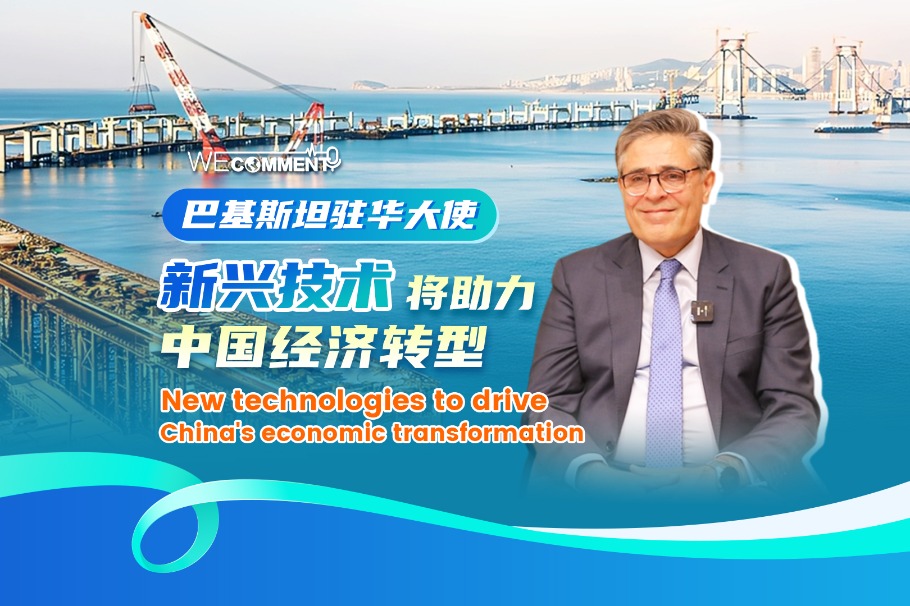Measures needed for expansionary growth
By Liu Shijin | China Daily | Updated: 2024-11-04 09:20

On Sept 26, the Political Bureau of the Communist Party of China Central Committee held a meeting to analyze and study the current economic situation and make further arrangements for economic work, sending signals of vowing to hit the targets for this year's economic and social development.
According to the meeting, the economy has been generally stable, with progress being made and the overall situation sound. It was pointed out at the meeting that the fundamentals and favorable conditions of China's economy — such as a broad market, strong economic resilience and great potential — remain unchanged.
At the same time, the meeting said there are some new developments and problems in the current economic performance. It is imperative to calmly and objectively look at the current economic situation from an overall perspective, face up to difficulties and have greater confidence. It is also imperative to focus efforts on key areas, take a proactive approach, effectively implement existing policies, intensify the introduction of new policies, and make policy measures even more targeted and effective.
At this stage, the basic situation in China is that there are over 400 million people in the middle-income group. The Gini coefficient has remained above 0.4 for many years, with some research suggesting it is at or above 0.45. The current challenge of insufficient demand is directly related to this demand structure.
To increase effective consumer demand, it is crucial to differentiate between survival-oriented consumption and development-oriented consumption. Survival-oriented consumption, primarily focuses on basic needs such as food and clothing, tends to stabilize, indicating that the basic issue of meeting basic needs has largely been resolved. This type of consumption is mainly individual.
Consumption growth is primarily driven by development-oriented consumption, which includes areas such as education, healthcare, affordable housing, social security, culture, sports, entertainment, financial services, transportation and communication. Development-oriented consumption often occurs through collective consumption or public services that directly relate to the level of equalization in government-provided public services. Expanding development-oriented consumption cannot rely solely on individual efforts, it requires the government to provide a platform, establish systems and invest funds, representing a combination of government consumption expenditure and household consumption expenditure.
The lag in the equalization of basic public services directly hinders the growth of development-oriented consumption. Currently, urban residents frequently express concerns about pressures related to education, healthcare and housing. The issue is even more pronounced for nearly 300 million migrant workers and around 200 million rural workers who have moved to cities and are lacking in basic public services. Therefore, expanding consumption must focus on two critical areas: first, development-oriented consumption that relies on basic public services; second, the middle- and low-income groups, particularly migrant workers.
The shortcomings in basic public services are directly related to the level of urbanization. Urban agglomeration effects reduce the cost of providing public services. In traditional rural areas, costs associated with modern infrastructure and basic public services are prohibitively high and difficult to reach. In comparison to developed economies at similar per capita income levels, China's urbanization rate is relatively low, with the urbanization rate of permanent residents at 66 percent. However, urbanization rates in developed economies typically exceed 70 percent, with some even surpassing 80 percent.
Without a certain density of urbanization, achieving high-level basic public services in education, healthcare, affordable housing, social security, elderly care, and cultural and entertainment sectors becomes difficult.
In light of the current economic situation, it is suggested to launch a plan to advance the economy that combines stimulus and reform measures to guide the economy back onto an expansionary growth path.
This plan aims to implement the reform measures related to integrated urban-rural development mapped out by the resolution adopted at the third plenary session of the 20th Central Committee of the Communist Party of China. It primarily focuses on fiscal policy and works in close cooperation with demand-side management to create a comprehensive effect of expanding consumption, stabilizing growth and preventing risks.
The main source of funding will be through the issuance of ultra-long-term special treasury bonds. Over a period of one to two years, a significant investment scale will be used to address the weak links in basic public services. Previously, the focus was on physical capital investment. Now, the emphasis shifts to human capital investment.
This stimulus plan will primarily drive consumption at the micro level while also boosting investment in real estate, infrastructure and services, to substantially expand domestic demand. Macroscopically, it can elevate the overall demand level, reduce the gap with total supply and drive positive growth in the GDP deflator.
Meanwhile, more efforts are needed to significantly enhance the level of basic public services in affordable housing, education, healthcare, social security and elderly care for new urban residents, particularly migrant workers. In the short term, the government should purchase unsold housing and convert it into affordable housing for new urban residents.
The government also needs to accelerate the development of small and medium-sized towns within metropolitan areas, driving a second wave of urbanization in China and establishing a high-quality, sustainable modern urban system based on integrated urban-rural development.
International experience shows that core cities within city clusters and metropolitan areas typically account for about 30 percent of urban populations. There remains significant development space for small and medium-sized towns beyond these core cities, which can accommodate over 60 percent of urban populations. This includes both the existing urban population being relocated and an influx from rural areas and other cities, making it suitable for the agglomeration of manufacturing and mid to low-end services. Within this framework, there is still room for development in real estate, infrastructure and other sectors.
It is also necessary to implement the reform measures mapped out by the resolution regarding facilitating greater urban-rural integration in planning, development and governance across the board, promoting equal exchanges and two-way flows of production factors between urban and rural areas, narrowing the disparities between the two and promote their shared prosperity and development.
According to the resolution, China will allow rural households to put houses under their legal ownership to good use by leasing them out, contributing them in the form of shares and engaging in cooperative ventures. It will promote orderly reforms for market-based transfers of rural collective land designated for business construction and improve the mechanisms for distributing returns realized from the appreciation of the land.
The focus should be on promoting a two-way autonomous flow of personnel, land and capital between urban and rural areas, optimizing the allocation and utilization of various resources based on market principles. Farmers should be able to move to cities, while urban residents should have opportunities to go to rural areas, creating greater opportunities for entrepreneurship, employment and housing in both urban and rural contexts. By further liberating thoughts and actively exploring the integration of rural homestead transfer and the improvement of rural social security systems as well as accelerating land system reforms, we can improve land use efficiency, increase property income for farmers, enhance social security capacity, improve housing conditions for urban and rural residents, and stabilize growth and upgrade structures — all yielding multiple benefits.
An important goal is to use the implementation of this plan to advance the economy as an opportunity to strive to double the middle-income population from the current 400 million to between 800 and 900 million within approximately ten years. Proposing and promoting the realization of this goal is fundamentally significant for extending the period of moderate growth and mitigating the adverse impacts of demand constraints on economic growth.
In the short term, this will help quickly close the gap in total demand, leading economic growth into an expansionary cycle, while employing a stimulus plus reform approach that will create favorable conditions for high-quality social and economic development over the medium to long term.
The writer is vice-chairman of the China Development Research Foundation and former deputy director of the Development Research Center of the State Council.
The views do not necessarily reflect those of China Daily.
























